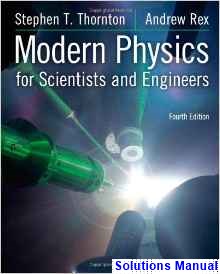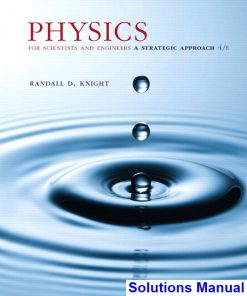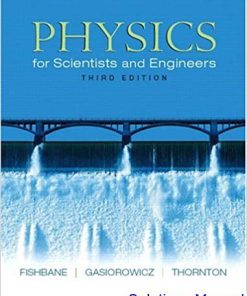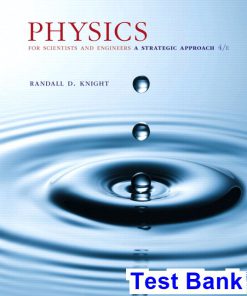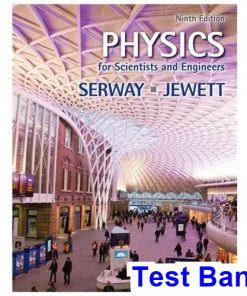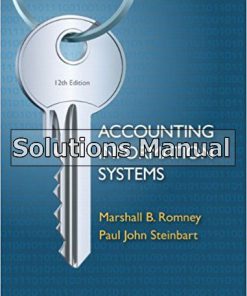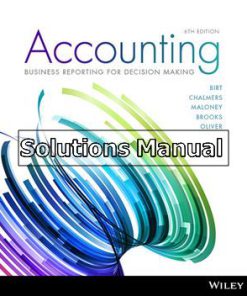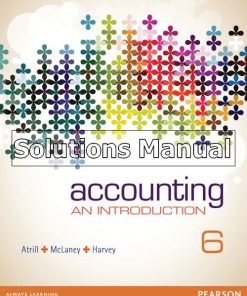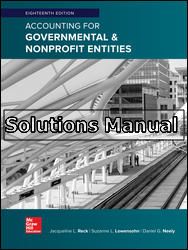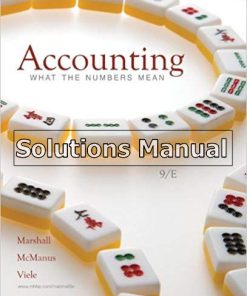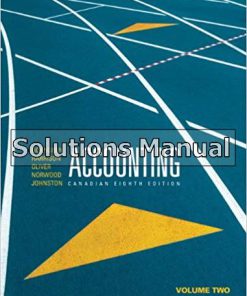Physics for Scientists and Engineers 3rd Edition Knight Solutions Manual
$26.50$50.00 (-47%)
Physics for Scientists and Engineers 3rd Edition Knight Solutions Manual.
You may also like
Instant download Physics for Scientists and Engineers 3rd Edition Knight Solutions Manual pdf docx epub after payment.
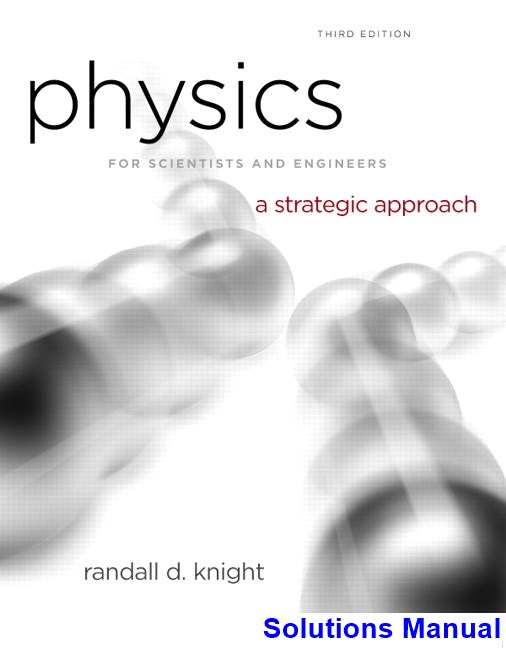
Product details:
- ISBN-10 : 0321752945
- ISBN-13 : 978-0321752949
- Author: Randall D. Knight (Professor Emeritus) (Author)
As the most widely adopted new physics book in more than 50 years, Knight’s Physics for Scientists and Engineers was published to widespread critical acclaim from professors and students. In the Third Edition, Knight builds on the research-proven instructional techniques he introduced in the first and second editions, as well as national data of student performance, to take student learning even further. Knight’s unparalleled insight into student learning difficulties, and his impeccably skillful crafting of text and figures at every level—from macro to micro—to address these difficulties, results in a uniquely effective and accessible book, leading students to a deeper and better-connected understanding of the concepts and more proficient problem-solving skills.
For the Third Edition, Knight continues to apply the best results from educational research, and to refine and tailor them for this course and its students. New pedagogical features (Chapter Previews, Challenge Examples, and Data-based Examples), end-of-chapter problem sets enhanced through analysis of national student metadata, and fine-tuned and streamlined content take the hallmarks of the previous editions—exceptionally effective conceptual explanation and problem-solving instruction—to a new level.
Table of contents:
Introduction Journey into Physics Part I Newton's Laws Overview Why Things Change Chapter 1 Concepts of Motion 1.1 Motion Diagrams 1.2 The Particle Model 1.3 Position and Time 1.4 Velocity 1.5 Linear Acceleration 1.6 Motion in One Dimension 1.7 Solving Problems in Physics 1.8 Units and Significant Figures SUMMARY QUESTIONS AND PROBLEMS Chapter 2 Kinematics in One Dimension 2.1 Uniform Motion 2.2 Instantaneous Velocity 2.3 Finding Position from Velocity 2.4 Motion with Constant Acceleration 2.5 Free Fall 2.6 Motion on an Inclined Plane 2.7 Instantaneous Acceleration SUMMARY QUESTIONS AND PROBLEMS Chapter 3 Vectors and Coordinate Systems 3.1 Vectors 3.2 Properties of Vectors 3.3 Coordinate Systems and Vector Components 3.4 Vector Algebra SUMMARY QUESTIONS AND PROBLEMS Chapter 4 Kinematics in Two Dimensions 4.1 Acceleration 4.2 Kinematics in Two Dimensions 4.3 Projectile Motion 4.4 Relative Motion 4.5 Uniform Circular Motion 4.6 Velocity and Acceleration in Uniform Circular Motion 4.7 Nonuniform Circular Motion and Angular Acceleration SUMMARY QUESTIONS AND PROBLEMS Chapter 5 Force and Motion 5.1 Force 5.2 A Short Catalog of Forces 5.3 Identifying Forces 5.4 What Do Forces Do? A Virtual Experiment 5.5 Newton's Second Law 5.6 Newton's First Law 5.7 Free-Body Diagrams SUMMARY QUESTIONS AND PROBLEMS Chapter 6 Dynamics I: Motion Along a Line 6.1 Equilibrium 6.2 Using Newton's Second Law 6.3 Mass, Weight, and Gravity 6.4 Friction 6.5 Drag 6.6 More Examples of Newton's Second Law SUMMARY QUESTIONS AND PROBLEMS Chapter 7 Newton's Third Law 7.1 Interacting Objects 7.2 Analyzing Interacting Objects 7.3 Newton's Third Law 7.4 Ropes and Pulleys 7.5 Examples of Interacting-Object Problems SUMMARY QUESTIONS AND PROBLEMS Chapter 8 Dynamics II: Motion in a Plane 8.1 Dynamics in Two Dimensions 8.2 Velocity and Acceleration in Uniform Circular Motion 8.3 Dynamics of Uniform Circular Motion 8.4 Circular Orbits 8.5 Fictitious Forces 8.6 Why Does the Water Stay in the Bucket? 8.7 Nonuniform Circular Motion SUMMARY QUESTIONS AND PROBLEMS Part Summary Newton's Laws Part II Conservation Laws Overview Why Some Things Don't Change Chapter 9 Impulse and Momentum 9.1 Momentum and Impulse 9.2 Solving Impulse and Momentum Problems 9.3 Conservation of Momentum 9.4 Inelastic Collisions 9.5 Explosions 9.6 Momentum in Two Dimensions SUMMARY QUESTIONS AND PROBLEMS Chapter 10 Energy 10.1 A "Natural Money" Called Energy 10.2 Kinetic Energy and Gravitational Potential Energy 10.3 A Closer Look at Gravitational Potential Energy 10.4 Restoring Forces and Hooke's Law 10.5 Elastic Potential Energy 10.6 Elastic Collisions 10.7 Energy Diagrams SUMMARY QUESTIONS AND PROBLEMS Chapter 11 Work 11.1 The Basic Energy Model 11.2 Work and Kinetic Energy 11.3 Calculating and Using Work 11.4 The Work Done by a Variable Force 11.5 Force, Work, and Potential Energy 11.6 Finding Force from Potential Energy 11.7 Thermal Energy 11.8 Conservation of Energy 11.9 Power SUMMARY QUESTIONS AND PROBLEMS Part Summary Conservation Laws Part III Applications of Newtonian Mechanics Overview Power Over Our Environment Chapter 12 Rotation of a Rigid Body 12.1 Rotational Motion 12.2 Rotation About the Center of Mass 12.3 Rotational Energy 12.4 Calculating Moment of Inertia 12.5 Torque 12.6 Rotational Dynamics 12.7 Rotation About a Fixed Axis 12.8 Static Equilibrium 12.9 Rolling Motion 12.10 The Vector Description of Rotational Motion 12.11 Angular Momentum of a Rigid Body SUMMARY QUESTIONS AND PROBLEMS Chapter 13 Newton's Theory of Gravity 13.1 A Little History 13.2 Isaac Newton 13.3 Newton's Law of Gravity 13.4 Little g and Big G 13.5 Gravitational Potential Energy 13.6 Satellite Orbits and Energies SUMMARY QUESTIONS AND PROBLEMS Chapter 14 Oscillations 14.1 Simple Harmonic Motion 14.2 Simple Harmonic Motion and Circular Motion 14.3 Energy in Simple Harmonic Motion 14.4 The Dynamics of Simple Harmonic Motion 14.5 Vertical Oscillations 14.6 The Pendulum 14.7 Damped Oscillations 14.8 Driven Oscillations and Resonance SUMMARY QUESTIONS AND PROBLEMS Chapter 15 Fluids and Elasticity 15.1 Fluids 15.2 Pressure 15.3 Measuring and Using Pressure 15.4 Buoyancy 15.5 Fluid Dynamics 15.6 Elasticity SUMMARY QUESTIONS AND PROBLEMS Part Summary Applications of Newtonian Mechanics Part IV Thermodynamics Overview It's All About Energy Chapter 16 A Macroscopic Description of Matter 16.1 Solids, Liquids, and Gases 16.2 Atoms and Moles 16.3 Temperature 16.4 Phase Changes 16.5 Ideal Gases 16.6 Ideal-Gas Processes SUMMARY QUESTIONS AND PROBLEMS Chapter 17 Work, Heat, and the First Law of Thermodynamics 17.1 It's All About Energy 17.2 Work in Ideal-Gas Processes 17.3 Heat 17.4 The First Law of Thermodynamics 17.5 Thermal Properties of Matter 17.6 Calorimetry 17.7 The Specific Heats of Gases 17.8 Heat-Transfer Mechanisms SUMMARY QUESTIONS AND PROBLEMS Chapter 18 The Micro/Macro Connection 18.1 Molecular Speeds and Collisions 18.2 Pressure in a Gas 18.3 Temperature 18.4 Thermal Energy and Specific Heat 18.5 Thermal Interactions and Heat 18.6 Irreversible Processes and the Second Law of Thermodynamics SUMMARY QUESTIONS AND PROBLEMS Chapter 19 Heat Engines and Refrigerators 19.1 Turning Heat into Work 19.2 Heat Engines and Refrigerators 19.3 Ideal-Gas Heat Engines 19.4 Ideal-Gas Refrigerators 19.5 The Limits of Efficiency 19.6 The Carnot Cycle SUMMARY QUESTIONS AND PROBLEMS Part Summary Thermodynamics Part V Waves and Optics Overview Beyond the Particle Model Chapter 20 Traveling Waves 20.1 The Wave Model 20.2 One-Dimensional Waves 20.3 Sinusoidal Waves 20.4 Waves in Two and Three Dimensions 20.5 Sound and Light 20.6 Power, Intensity , and Decibels 20.7 The Doppler Effect SUMMARY QUESTIONS AND PROBLEMS Chapter 21 Superposition 21.1 The Principle of Superposition 21.2 Standing Waves 21.3 Transverse Standing Waves 21.4 Standing Sound Waves and Musical Acoustics 21.5 Interference in One Dimension 21.6 The Mathematics of Interference 21.7 Interference in Two and Three Dimensions 21.8 Beats SUMMARY QUESTIONS AND PROBLEMS Chapter 22 Wave Optics 22.1 Light and Optics 22.2 The Interference of Light 22.3 The Diffraction Grating 22.4 Single-Slit Diffraction 22.5 Circular-Aperture Diffraction 22.6 Interferometers SUMMARY QUESTIONS AND PROBLEMS Chapter 23 Ray Optics 23.1 The Ray Model of Light 23.2 Reflection 23.3 Refraction 23.4 Image Formation by Refraction 23.5 Color and Dispersion 23.6 Thin Lenses: Ray Tracing 23.7 Thin Lenses: Refraction Theory 23.8 Image Formation with Spherical Mirrors SUMMARY QUESTIONS AND PROBLEMS Chapter 24 Optical Instruments 24.1 Lenses in Combination 24.2 The Camera 24.3 Vision 24.4 Optical Systems that Magnify 24.5 The Resolution of Optical Instruments SUMMARY QUESTIONS AND PROBLEMS Chapter 25 Modern Optics and Matter Waves 25.1 Spectroscopy: Unlocking the Structure of Atoms 25.2 X-Ray Diffraction 25.3 Photons 25.4 Matter Waves 25.5 Energy is Quantized SUMMARY QUESTIONS AND PROBLEMS Part Summary Waves and Optics Part VI Electricity and Magnetism Overview Charges, Currents, and Fields Chapter 26 Electric Charges and Forces 26.1 Developing a Charge Model 26.2 Charge 26.3 Insulators and Conductors 26.4 Coulomb's Law 26.5 The Field Model SUMMARY QUESTIONS AND PROBLEMS Chapter 27 The Electric Field 27.1 Electric Field Models 27.2 The Electric Field of Multiple Point Charges 27.3 The Electric Field of a Continuous Charge Distribution 27.4 The Electric Fields of Rings, Disks, Planes, and Spheres 27.5 The Parallel-Plate Capacitor 27.6 Motion of a Charged Particle in an Electric Field 27.7 Motion of a Dipole in an Electric Field SUMMARY QUESTIONS AND PROBLEMS Chapter 28 Gauss's Law 28.1 Symmetry 28.2 The Concept of Flux 28.3 Calculating Electric Flux 28.4 Gauss's Law 28.5 Using Gauss's Law 28.6 Conductors in Electrostatic Equilibrium SUMMARY QUESTIONS AND PROBLEMS Chapter 29 The Electric Potential 29.1 Electric Potential Energy 29.2 The Potential Energy of Point Charges 29.3 The Potential Energy of a Dipole 29.4 The Electric Potential 29.5 The Electric Potential Inside a Parallel-Plate Capacitor 29.6 The Electric Potential of a Point Charge 29.7 The Electric Potential of Many Charges SUMMARY QUESTIONS AND PROBLEMS Chapter 30 Potential and Field 30.1 Connecting Potential and Field 30.2 Sources of Electric Potential 30.3 Finding the Electric Field from the Potential 30.4 A Conductor in Electrostatic Equilibrium 30.5 Capacitance and Capacitors 30.6 The Energy Stored in a Capacitor 30.7 Dielectrics SUMMARY QUESTIONS AND PROBLEMS Chapter 31 Current and Resistance 31.1 The Electron Current 31.2 Creating a Current 31.3 Current and Current Density 31.4 Conductivity and Resistivity 31.5 Resistance and Ohm's Law SUMMARY QUESTIONS AND PROBLEMS Chapter 32 Fundamentals of Circuits 32.1 Circuit Elements and Diagrams 32.2 Kirchhoff's Laws and the Basic Circuit 32.3 Energy and Power 32.4 Series Resistors 32.5 Real Batteries 32.6 Parallel Resistors 32.7 Resistor Circuits 32.8 Getting Grounded 32.9 RC Circuits SUMMARY QUESTIONS AND PROBLEMS Chapter 33 The Magnetic Field 33.1 Magnetism 33.2 The Discovery of the Magnetic Field 33.3 The Source of the Magnetic Field: Moving Charges 33.4 The Magnetic Field of a Current 33.5 Magnetic Dipoles 33.6 Ampère's Law and Solenoids 33.7 The Magnetic Force on a Moving Charge 33.8 Magnetic Forces on Current-Carrying Wires 33.9 Forces and Torques on Current Loops 33.10 Magnetic Properties of Matter SUMMARY QUESTIONS AND PROBLEMS Chapter 34 Electromagnetic Induction 34.1 Induced Currents 34.2 Motional emf 34.3 Magnetic Flux 34.4 Lenz's Law 34.5 Faraday's Law 34.6 Induced Fields 34.7 Induced Currents: Three Applications 34.8 Inductors 34.9 LC Circuits 34.10 LR Circuits SUMMARY QUESTIONS AND PROBLEMS Chapter 35 Electromagnetic Fields and Waves 35.1 E or B? It Depends on Your Perspective 35.2 The Field Laws Thus Far 35.3 The Displacement Current 35.4 Maxwell's Equations 35.5 Electromagnetic Waves 35.6 Properties of Electromagnetic Waves 35.7 Polarization SUMMARY QUESTIONS AND PROBLEMS Chapter 36 AC Circuits 36.1 AC Sources and Phasors 36.2 Capacitor Circuits 36.3 RC Filter Circuits 36.4 Inductor Circuits 36.5 The Series RLC Circuit 36.6 Power in AC Circuits SUMMARY QUESTIONS AND PROBLEMS Part Summary Electricity and Magnetism Part VII Relativity and Quantum Physics Overview Contemporary Physics Chapter 37 Relativity 37.1 Relativity: What's It All About? 37.2 Galilean Relativity 37.3 Einstein's Principle of Relativity 37.4 Events and Measurements 37.5 The Relativity of Simultaneity 37.6 Time Dilation 37.7 Length Contraction 37.8 The Lorentz Transformations 37.9 Relativistic Momentum 37.10 Relativistic Energy SUMMARY QUESTIONS AND PROBLEMS Chapter 38 The End of Classical Physics 38.1 Physics in the 1800s 38.2 Faraday 38.3 Cathode Rays 38.4 J. J. Thomson and the Discovery of the Electron 38.5 Millikan and the Fundamental Unit of Charge 38.6 Rutherford and the Discovery of the Nucleus 38.7 Into the Nucleus 38.8 The Emission and Absorption of Light 38.9 Classical Physics at the Limit SUMMARY QUESTIONS AND PROBLEMS Chapter 39 Quantization 39.1 The Photoelectric Effect 39.2 Einstein's Explanation 39.3 Photons 39.4 Matter Waves and Energy Quantization 39.5 Bohr's Model of Atomic Quantization 39.6 The Bohr Hydrogen Atom 39.7 The Hydrogen Spectrum SUMMARY QUESTIONS AND PROBLEMS Chapter 40 Wave Functions and Uncertainty 40.1 Waves, Particles, and the Double-Slit Experiment 40.2 Connecting the Wave and Photon Views 40.3 The Wave Function 40.4 Normalization 40.5 Wave Packets 40.6 The Heisenberg Uncertainty Principle SUMMARY QUESTIONS AND PROBLEMS Chapter 41 One-Dimensional Quantum Mechanics 41.1 Schrödinger's Equation: The Law of Psi 41.2 Solving the Schrödinger Equation 41.3 A Particle in a Rigid Box: Energies and Wave Functions 41.4 A Particle in a Rigid Box: Interpreting the Solution 41.5 The Correspondence Principle 41.6 Finite Potential Wells 41.7 Wave-Function Shapes 41.8 The Quantum Harmonic Oscillator 41.9 More Quantum Models 41.10 Quantum-Mechanical Tunneling SUMMARY QUESTIONS AND PROBLEMS Chapter 42 Atomic Physics 42.1 The Hydrogen Atom: Angular Momentum and Energy 42.2 The Hydrogen Atom: Wave Functions and Probabilities 42.3 The Electron's Spin 42.4 Multielectron Atoms 42.5 The Periodic Table of the Elements 42.6 Excited States and Spectra 42.7 Lifetimes of Excited States 42.8 Stimulated Emission and Lasers SUMMARY QUESTIONS AND PROBLEMS Chapter 43 Nuclear Physics 43.1 Nuclear Structure 43.2 Nuclear Stability 43.3 The Strong Force 43.4 The Shell Model 43.5 Radiation and Radioactivity 43.6 Nuclear Decay Mechanisms 43.7 Biological Applications of Nuclear Physics SUMMARY QUESTIONS AND PROBLEMS Part Summary Relativity and Quantum Physics Appendix A Mathematics Review Appendix B Periodic Table of Elements Appendix C Atomic and Nuclear Data Answers to Odd-Numbered Questions Credits Index
People also search:
Physics for Scientists and Engineers 3rd Edition
Physics for Scientists and Engineers 3rd Edition pdf
Physics for Scientists and Engineers
fundamental math and physics for scientists and engineers
physics for scientists and engineers a strategic approach
|
physics for scientists and engineers conceptual questions answers
|

